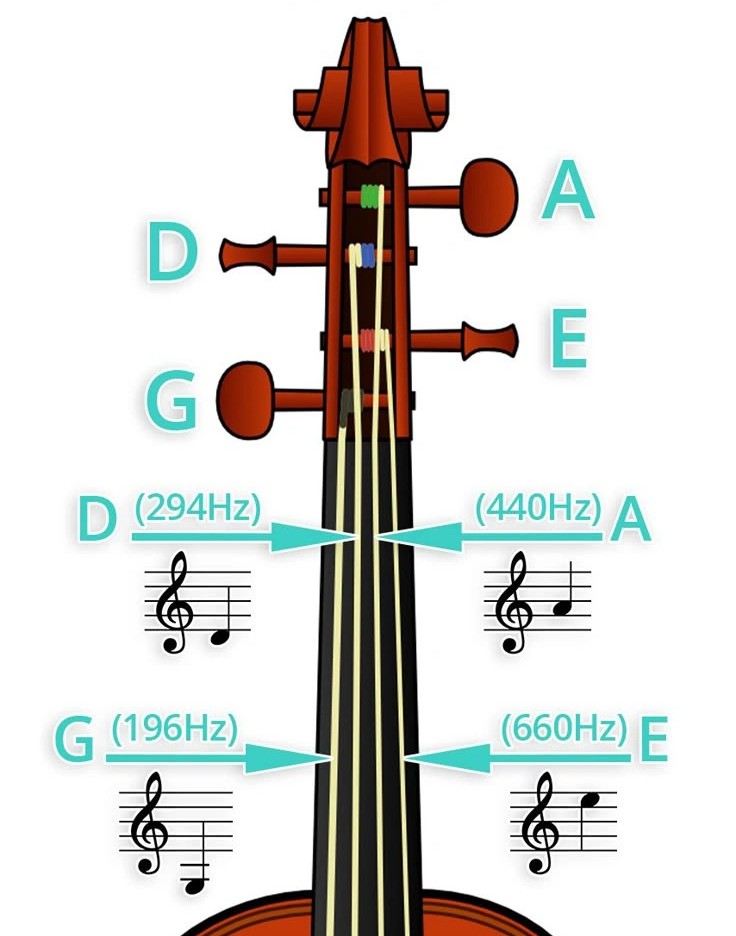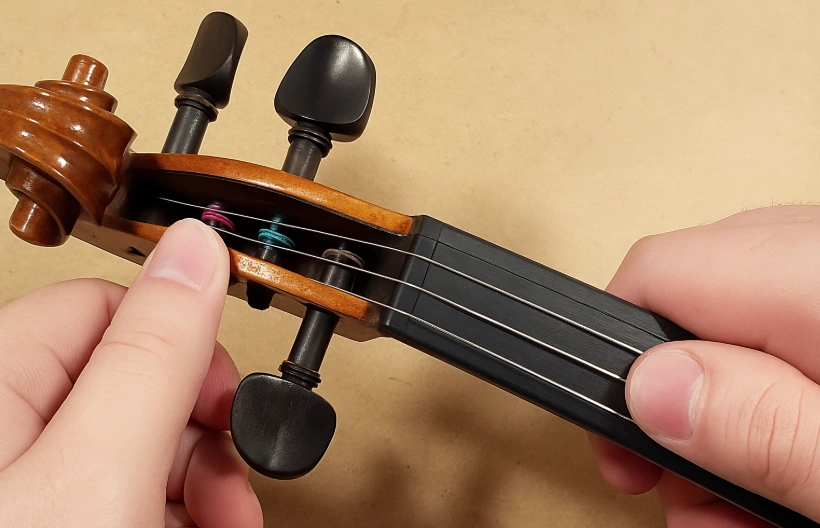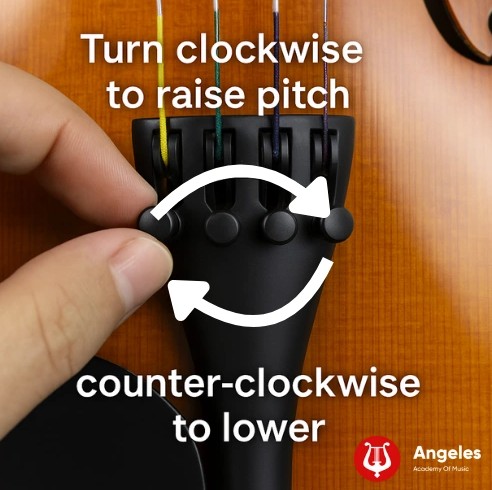Violin tuning isn’t sorcery. It’s a short routine: set a reference (A=440), tune A–D–G–E, make big moves with pegs and tiny moves with fine tuners, then re-check.
But only if it were that simple…
Which is why this comprehensive guide will walk you through violin tuning pegs vs fine tuners, the proper tuning order (standard tuning for violin is G3-D4-A4-E5), using tuner apps or an online violin tuner, tuning by ear, dealing with bridge and peg issues, string stretching, and more.
Whether you’re a young student, an adult beginner, or a parent supervising practice, you’ll find practical tips to make violin tuning easier. This is the most comprehensive guide you’ll find on violin tuning.
What “In Tune” Means (and Why Fifths Matter)
In Simple Words:
When your violin is in tune, it means each of its four strings is making the right sound it’s supposed to. Not too high, not too low. Those strings are tuned to these notes (from the lowest-sounding to the highest): G, D, A, and E.
Think of it like four voices in a choir that need to blend together. If even one person sings off-key, the harmony feels off. The violin works the same way. All four strings must be in the right relationship to sound smooth and beautiful together.
These are the pitches every violinist in the world uses:
- G (the lowest string)
- D
- A (the main tuning note, matched to 440 Hz)
- E (the highest string)
This is called the standard violin tuning. It’s the same for beginners, professionals, and orchestras everywhere.

Understanding Standard Violin Tuning (G-D-A-E)
Standard violin tuning uses four strings tuned in perfect fifths: G-D-A-E (from lowest-pitched G on the left to highest E on the right).
Each string’s pitch is a perfect fifth apart, which means if you play them in order, they sound like the beginning of “Twinkle, Twinkle Little Star.” In scientific terms, the violin’s strings are tuned to G₃, D₄, A₄, and E₅. This is the universal standard tuning for the violin.
- G3 = 196 Hz
- D4 = 293.7 Hz
- A4 = 440 Hz (your reference pitch)
- E5 = 659.3 Hz
Sometimes, fiddlers or folk musicians use special tunings (like A–E–A–E) for a different sound, kind of like changing the settings on a guitar. But for anyone learning or taking lessons, G–D–A–E is home base. It’s where every player starts.
If you need help understanding violin parts, click here.
Tools You’ll Use
Use fine tuners for small corrections and tuning pegs for big ones. Add a violin tuner (clip-on or app) for feedback.
- Fine tuners (on the tailpiece): Turn clockwise to raise pitch, counter-clockwise to lower. Great for kids and daily micro-tweaks.
- Violin tuning pegs (in the pegbox): For large changes (after string changes or big overnight drift). Learn the safe “loosen-then-tighten” method below.
- Digital options: look for: tuner violin, online violin tuner, violin tuner online, or a phone app (iOS/Android). These “violin tuning online” tools listen through your mic and show sharp/flat in real time.
Apps like Tunable, Pano Tuner, or DaTuner work great. Or try Violinspiration’s online tuner for orchestral accuracy.

Equip Smartly
The 7-Minute, No-Drama Tuning Routine (A–D–G–E)
Using a chromatic tuner or app, tune A → D → G → E, then re-check A. Pegs for big moves, fine tuners for precision.
Set your reference (A=440). Open your app or clip-on. Pluck/bow the A string; center the needle.
- Tune A precisely. If A is close, use the fine-tuner. If way off (wrong letter), loosen slightly, then use the A peg to approach the note, pushing the peg inward while turning; finish with the fine tuner.
- Tune D, then G. Each should be a fifth below the previous. Use the same peg-then-fine-tune dance.
- Tune E last. E is thin and sensitive; leaving it last avoids chasing changes caused by the lower strings.
- Re-check A. Strings interact; a quick second pass locks things in.
- Quick bridge check. Ensure the bridge stands upright (not leaning toward the fingerboard). Nudge gently if needed.
- Play double-stops (A+E, A+D). Listen: clean open-fifths= success.
How to Use Pegs Safely (Without Snapping a String)
Loosen a string first → pluck continuously → tighten slowly clockwise while gently pushing the peg inward → finish with a fine tuner.

- Loosen first: Drop pitch slowly to prevent any drastic pitch changes.
- Pluck as you turn: Real-time feedback = fewer overshoots.
- Push inward: Pegs are tapered; a gentle inward push adds friction so they don’t slip back.
- Tiny movements: Millimeters matter. Stop near pitch and switch to fine tuners.
- Reset fine tuners: If a fine tuner bottoms out (fully tight), back it off, use the peg to get close, then fine-tune again.
With pegs, get the pitch as close as possible to right below/above the pitch, and then we use fine tuners.
Remember, “Peg anxiety” is normal. Even experienced players treat pegs with respect. But learning to handle pegs is important for any violinist. The safest way to use pegs involves loosening first and sneaking up to the pitch, always pushing the peg inward to secure it. The motto here is “righty tighty, lefty loosey.”
If a peg slips: Try again with a firmer inward push. Chronic slipping or sticking? Ask a luthier about peg compound or consider geared pegs (Wittner-style) for stress-free tuning.
Meanwhile, fine-tuners are your friend.
Using Fine-Tuners Like a Pro
Fine tuners do precision; let them save you time (and strings).

- Clockwise = sharper, counter-clockwise = flatter
- Pluck twice per second while turning; stop when the tuner centers.
- Don’t crank to the plate. If the screw is nearly maxed, back off and “reset” with the peg.
- Keep an eye out for buzzing from a very loose screw; snug it (not to tune, just to stop rattles).
Tuning by Ear (Optional Skill)
Once you’re comfortable using a tuner, you can start training your ear to tune naturally, without looking at a screen. First, tune your A string using a tuner or piano. Then, listen carefully as you play two strings together (A and D, D and G, or A and E).
When they blend into one smooth, steady sound, without any pulsing or wobbling, that means they’re in tune.
At first, this takes a little practice, but it’s one of the best ways to develop musical hearing. You can always double-check with your tuner afterward to see how close you got.
Tuning Order for Stability
Why Violins Go Out of Tune (and How to Cope)
New strings, weather, peg fit, and playing vibration cause pitch drift. Daily quick checks are normal.
Even after you’ve tuned perfectly, violins have a mischievous way of slipping out of tune. Especially in Los Angeles, where a morning might be dry and an afternoon quite humid, you might find your violin tuning itself to a new pitch by the next day.
- New strings stretch: Expect frequent retunes for 3–10 sessions. Gently pre-stretch after tuning (small tug), then re-tune.
- Humidity & temperature: Wood moves; pegs slip/stick. Consider a case humidifier in dry seasons and avoid leaving the case in a hot car.
- Bridge creep: Tuning can pull the bridge forward. Check it stays upright; ask your teacher to show a safe micro-adjust.
- Old strings go “false”: If tuning won’t stabilize and tone is dull, it’s time for a fresh set.
- Bow pressure. Beginners often press very hard with the bow, which can cause the pitch of a note to sound off (bend sharp). An intonation/articulation issue. Ensure you’re drawing the bow correctly. A proper bow stroke won’t change the pitch.
How often should I tune my violin?
Every time you play. Typically, violinists tune up at the start of each practice or rehearsal session. Often it’s just minor tweaks, but you check it. In a lesson, your teacher might help tune at the beginning (especially for kids).
But ideally, if you’re practicing daily, you should check tuning each day. If the violin has sat for a while (like a week's vacation), it will definitely need tuning. Sometimes, even mid-practice if you’re really getting into it, it’s okay to quickly recheck tuning.
Tuning Tips for Kids & Parents
Start kids with fine tuners only. Parents can handle pegs until the child learns proper control.
- Ages 5–8: Watch and learn the tuning order (A→D→G→E).
- Ages 9–12: Start supervised peg practice on G or D (thicker strings).
- Visual feedback: Apps with big needles or smiley indicators make “center the pitch” intuitive.
- Safety: Keep faces away from string path when turning pegs (especially E). If anything feels stuck, stop and ask a teacher.
Importantly, teach kids to always ask for help if something feels off or if a peg is stuck. A youngster should never force things.
I tell my students, “The violin is tough to tune. Even grown-ups ask violin shop folks for help sometimes. So if it doesn’t feel right, pause and get help.” This avoids them developing bad habits like using pliers on pegs or ignoring a tilting bridge.
Another Parent Insight:
When parents ask,
“Is my child ready to tune alone?”
The answer depends on hand strength, patience, focus, and listening skills, not just age.
Tuning isn’t only about turning pegs; it’s also about developing ear training, but how well a child can hear small differences in pitch and respond carefully. Kids who can stay focused, follow slow instructions, and take their time adjusting will find the process smoother.
It’s less about rushing toward independence and more about building a habit of deliberation and attention to sound.
Ready for step-by-step help (including painless peg practice)? Work with a teacher who tunes with you, not just for you.
→ Book Violin Lessons at Angeles Academy of Music
Fixing Common Violin Tuning Problems (and How To Prevent Them)
Most tuning issues aren’t “bad violins.” They’re minor setup, climate, or habit problems. Fix them once, and daily tuning becomes effortless.
1. Slipping Pegs
A slipping peg happens when the peg loses friction with the pegbox.
- Push inward as you twist, adding gentle pressure.
- If it still pops loose, rub peg compound (a soft chalk/soap blend) on contact points.
Recommendations: Hill Peg Compound (W.E. Hill & Sons), Pirastro Peg Paste, Hidersine Hiderpaste Peg Paste - Avoid chalk dust or rosin. They grab too hard and may crack the pegbox.
2. Sticking Pegs
This is the opposite of slipping pegs. Sometimes pegs jam because of humidity or swelling.
- Start by loosening first: gently turn the peg counterclockwise to release some tension. If you try to tighten a stuck peg right away, the string might snap.
- Once it loosens slightly, turn it back and forth a few times to free it up. If it still won’t move, don’t force it. Stop and ask your teacher or a luthier for help.
- Store violins in moderate humidity (40–50%): Los Angeles’s dry climate + AC can make pegs unpredictable.
3. Bridge Tilt
Over-tuning often pulls the bridge toward the fingerboard.
- From the side, the bridge should lean slightly back toward the tailpiece.
- If it’s forward, gently nudge the top back using both thumbs while bracing the violin body.
- Regular teachers’ check-ups prevent this from becoming a full reset.
4. New String Stretch
Fresh strings take a week or two to settle.
- Pre-stretch gently after each tuning (small upward tugs).
- Tune, play for 5 minutes, re-tune. Repeat daily.
- Synthetic-core strings (Dominant, Vision) stabilize faster than gut-core.
Pro Tip: Record yourself each day. Hearing how tone stabilizes helps you “feel” the difference between tuning drift and ear illusion.
5. String Breaks
Strings rarely “snap.” They fatigue or kink.
- Loosen gently, not abruptly.
- Avoid tightening cold strings immediately after opening the case (wait 2–3 minutes for temperature adjustment).
- Always keep a spare E string. It’s the one that goes first.
Tuning Tips for Adult/Teenage Beginners
1. Unlearn “Guitar Logic”
If you’ve played guitar, forget that reflex. Violin pegs aren’t geared — tiny turns make big changes. Move slowly and keep plucking or bowing so you hear every shift. If unsure, stop and reset. With time, your hands will learn the feel naturally.
2. Use Your Environment
Tune in a quiet, echo-free room. Hold the violin on your collarbone, not your lap, for accurate tension. In coastal LA (Santa Monica, Venice), humidity can flatten your pitch, so tune right before playing. In studio-heavy areas like Burbank or Pasadena, re-check after long A/C sessions.
3. Smart Tuner Habits
Use both your eyes and ears. Watch for a steady green light, then confirm with double-stops (A+D, D+G, A+E). Digital tuners can mislead under bow pressure, so listen too.
4. Stay Patient
Even pros tune before every session. Tuning isn’t a one-time task; it’s a daily calibration. After a month of doing it yourself, you’ll know when something’s off before you even check the tuner.
At Angeles Academy, instructors model both peg and fine-tuning techniques, so parents can reinforce them at home confidently. Work with a qualified and experienced teacher in Los Angeles.
Ready for personal feedback on tuning posture and peg handling? → Book The Best Violin Lessons in Los Angeles at Angeles Academy of Music
Tuning Myths vs. Truths
Quick Diagnostics: “Why Does My Violin Sound Wrong?”
Los Angeles Violin Tuning Habits
Los Angeles violinists battle temperature jumps: morning fog, afternoon heat, then cold AC. Here’s what local pros do:
- West LA / Santa Monica: Salt air flattens strings → tune closer to session time.
- Pasadena / Burbank studios: A/C cycles make strings go sharp; tune before each take.
- Hollywood bowl performers: Keep instruments cased until right before tuning—direct sun warps pitch fast.
FAQ: The Most Common Violin Tuning Questions
How do I tune my violin online?
Use a violin tuning online tool like Violinspiration’s tuner or a clip-on tuner. Follow G–D–A–E order.
Should a Violin Be Tuned to 440 or 442?
Most beginners (and orchestras in the U.S.) tune to A=440 Hz, the international standard. Some advanced players and European orchestras prefer A=442 Hz for a slightly brighter tone, especially in ensembles.
Is Tuning a Violin Easy?
It becomes easy with practice. At first, it feels delicate because pegs respond sharply to small turns. But with daily use, you’ll learn how far to move and how much tension to expect.
Fine tuners make it much simpler. Most students can tune accurately within a week or two of consistent lessons.
My violin goes out of tune daily. Is that normal?
Yes. Humidity, string stretch, and bridge tension cause drift. Tune before each session.
How can kids learn tuning safely?
Start with fine-tuners. Parents can assist until kids (usually 9–12) can push pegs safely.
Should I tune by ear or use a tuner?
Use both. Tuners build reference memory; ear-tuning develops musicianship.
What’s “just intonation” vs “equal temperament”?
Just = pure natural fifths (what your ear likes). Equal = slight math adjustment (what pianos use). Both are fine—solo = just, with piano = equal.
What if my bridge keeps leaning?
Check alignment weekly. If unsure, bring it to a teacher or Angeles Academy of Music for a quick setup check.
🎻 Want hands-on guidance on Violin Tuning & Other aspects of the instrument? At Angeles Academy of Music in Los Angeles, our instructors teach tuning alongside techniques and right habits, from your child’s first bow hold to confident solo performance.
Private violin lessons for beginners, adults, and kids are available at our Westwood, Brentwood, and Pasadena locations.
.svg)
.svg)
.svg)
.svg)
.svg)
.svg)





.svg)